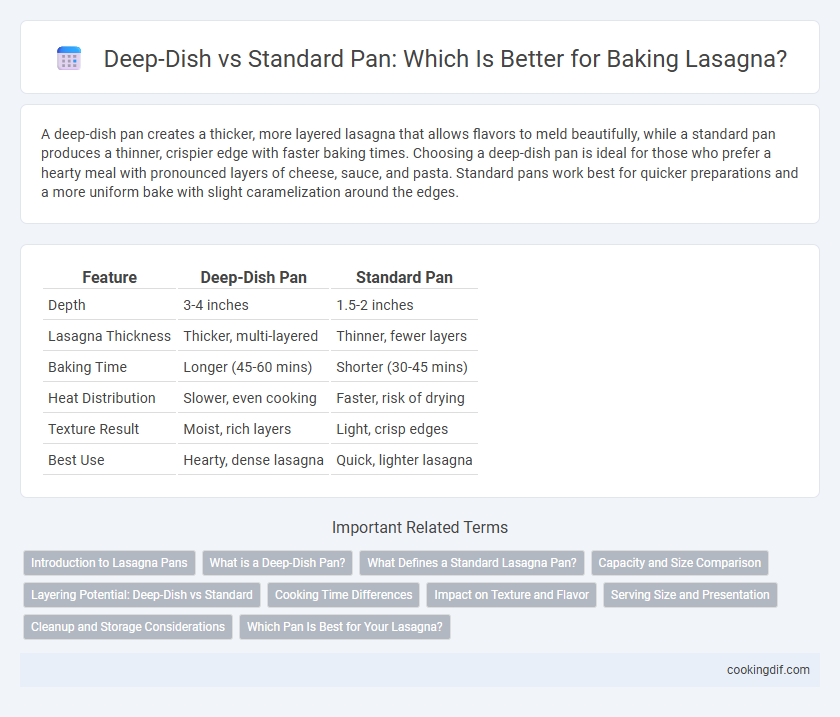A deep-dish pan creates a thicker, more layered lasagna that allows flavors to meld beautifully, while a standard pan produces a thinner, crispier edge with faster baking times. Choosing a deep-dish pan is ideal for those who prefer a hearty meal with pronounced layers of cheese, sauce, and pasta. Standard pans work best for quicker preparations and a more uniform bake with slight caramelization around the edges.
Table of Comparison
| Feature | Deep-Dish Pan | Standard Pan |
|---|---|---|
| Depth | 3-4 inches | 1.5-2 inches |
| Lasagna Thickness | Thicker, multi-layered | Thinner, fewer layers |
| Baking Time | Longer (45-60 mins) | Shorter (30-45 mins) |
| Heat Distribution | Slower, even cooking | Faster, risk of drying |
| Texture Result | Moist, rich layers | Light, crisp edges |
| Best Use | Hearty, dense lasagna | Quick, lighter lasagna |
Introduction to Lasagna Pans
Deep-dish pans provide greater depth, allowing for thicker, layered lasagnas with more sauce and cheese, enhancing flavor absorption. Standard pans offer a shallower profile, resulting in quicker cooking times and a firmer, crispier top layer. Choosing between deep-dish and standard pans depends on desired portion size and texture preferences in authentic lasagna preparation.
What is a Deep-Dish Pan?
A deep-dish pan is characterized by its taller sides, typically ranging from 3 to 4 inches in height, allowing for thicker layers in dishes like lasagna. This type of pan provides ample space for multiple layers of pasta, sauce, cheese, and fillings, ensuring even cooking and a rich, hearty texture. Compared to standard pans with shallower sides, deep-dish pans help retain moisture and enhance the overall depth and flavor profile of baked lasagna.
What Defines a Standard Lasagna Pan?
A standard lasagna pan typically measures around 9x13 inches and has a depth of 2 to 3 inches, allowing for multiple layers of pasta, sauce, and cheese to cook evenly. This size is designed to balance portion control with efficient heat distribution, ensuring the lasagna cooks thoroughly without drying out. In contrast, deep-dish pans exceed 3 inches in depth, enabling thicker layers and larger servings but may require longer baking times for optimal texture and flavor.
Capacity and Size Comparison
Deep-dish pans for lasagna typically offer a capacity ranging from 3 to 5 quarts, enabling thicker layers and more servings compared to standard pans, which usually hold around 2 to 3 quarts. The larger size of deep-dish pans often measures about 9x13 inches with deeper sides, while standard pans are shallower, generally around 8x8 or 9x9 inches. This difference in capacity and size influences cooking time and heat distribution, with deep-dish pans requiring longer baking to ensure even cooking throughout thicker layers.
Layering Potential: Deep-Dish vs Standard
Deep-dish pans provide increased layering potential for lasagna, allowing for more pasta, sauce, and cheese layers without overflow or structural collapse. Standard pans offer limited depth, which may restrict the number of layers and impact the texture and presentation of the lasagna. Choosing a deep-dish pan enhances the ability to create a thicker, more evenly cooked dish with distinct, flavorful layers.
Cooking Time Differences
A deep-dish pan significantly increases lasagna cooking time compared to a standard pan because its greater depth requires more heat penetration to thoroughly cook all layers. Standard pans, being shallower, allow for faster, more even heat distribution, typically reducing baking time by 10 to 15 minutes. Adjusting cooking time based on pan depth ensures proper texture and prevents undercooked interiors in deep-dish lasagna.
Impact on Texture and Flavor
Using a deep-dish pan for lasagna results in thicker layers that retain more moisture, producing a creamier texture and richer flavor as the ingredients meld during extended baking. In contrast, a standard pan creates thinner layers that bake more quickly, yielding a firmer texture with more caramelized edges and a slightly drier, concentrated taste. The choice of pan size significantly influences the final balance between softness and crispiness, shaping the lasagna's overall mouthfeel and flavor intensity.
Serving Size and Presentation
Using a deep-dish pan for lasagna baking allows for thicker, more layered servings, enhancing the dish's richness and visual appeal. Standard pans produce thinner layers with a more uniform structure, ideal for consistent portion sizes and easier slicing. Deep-dish pans create a more dramatic presentation with taller slices, while standard pans offer a classic, evenly baked appearance.
Cleanup and Storage Considerations
Deep-dish pans for lasagna often have a thicker, nonstick coating that eases cleanup by preventing food from sticking, while their larger size may require more storage space. Standard pans, usually lighter and shallower, are easier to store in typical kitchen cabinets but may need more effort to clean due to thinner surfaces prone to food residue. Choosing between deep-dish and standard pans depends on balancing ease of cleaning and available storage space in the kitchen.
Which Pan Is Best for Your Lasagna?
Deep-dish pans provide extra depth, perfect for layering more ingredients and achieving a thicker, heartier lasagna with evenly cooked edges. Standard pans offer a shallower depth, ideal for thinner, crispier lasagna slices and faster baking times. Choosing between deep-dish and standard pans depends on whether you prefer a dense, saucy texture or a lighter, more browned finish.
Deep-dish pan vs standard pan for baking Infographic

 cookingdif.com
cookingdif.com